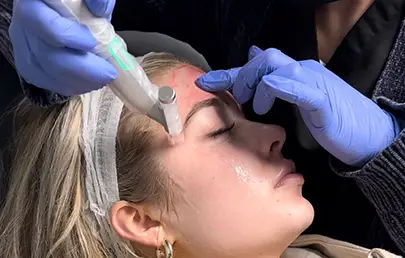How Does Microneedling Work?

How Does Microneedling Work?
If you’ve been exploring ways to rejuvenate your skin, you’ve probably heard of microneedling — a popular, minimally invasive cosmetic procedure praised for its ability to improve skin texture, tone, and overall appearance. But how exactly does microneedling work? Here’s a closer look at how this skin-rejuvenating treatment actually works.
Microneedling, sometimes called collagen induction therapy, is a minimally invasive cosmetic procedure designed to stimulate your skin’s natural healing process. Using a specialized device equipped with very fine needles, the treatment creates tiny, controlled punctures on the skin’s surface. Although it might sound intimidating, these micro-injuries are the key to unlocking your skin’s rejuvenation potential.
Unlike more aggressive treatments such as chemical peels or laser resurfacing, microneedling works gently by encouraging your skin to heal itself from the inside out, resulting in smoother, firmer, and more radiant skin.
The Science: How Microneedling Works
1. Controlled Micro-Injuries
The microneedling device often a pen-like tool with multiple fine needles — is rolled or stamped across the skin to create controlled micro-injuries. These punctures are extremely small and only penetrate the superficial layers of the skin.
2. Body’s Natural Healing Response
When your skin senses damage, it kicks into repair mode. The micro-injuries signal the body to produce new collagen and elastin — two key proteins responsible for skin strength, elasticity, and youthful appearance. This process is called collagen induction.
3. Collagen and Elastin Remodeling
Collagen strengthens skin and elastin keeps it flexible, but both decline with age, leading to wrinkles and sagging. Microneedling boosts their production, gradually smoothing fine lines, fading scars, tightening skin, and improving texture over time.
4. Enhanced Absorption of Skincare Products
The tiny channels created during microneedling temporarily bypass the skin’s natural barrier, allowing topical products applied immediately afterward to penetrate deeper and work more effectively. This means serums packed with vitamins, antioxidants, and hydrating ingredients can deliver enhanced results compared to when applied on untreated skin.
What Skin Concerns Can Microneedling Address?
Microneedling is versatile and can improve a variety of skin concerns, including:
- Fine lines and wrinkles — by stimulating collagen production to smooth the skin.
- Acne scars and surgical scars — by breaking down scar tissue and promoting regeneration.
- Hyperpigmentation and uneven skin tone — by encouraging skin cell turnover.
- Enlarged pores — by strengthening surrounding skin and reducing pore size.
- Stretch marks — through collagen remodeling in the affected areas.
- Overall skin texture and firmness — by boosting skin health and renewal.
Is Microneedling Safe?
When performed by a trained professional with sterile equipment, microneedling is generally safe and suitable for most skin types. Some mild redness and sensitivity may occur after the treatment, but these typically subside within a few days.
How Many Sessions Will You Need?
While some improvements may be visible after a single session, optimal results often require a series of treatments spaced about 4 to 6 weeks apart. Most people undergo 3 to 6 sessions depending on their individual skin goals and concerns.
Microneedling works by harnessing your body’s natural healing powers to stimulate collagen and elastin production. Through controlled micro-injuries, it refreshes and revitalizes your skin from within, helping you achieve a healthier, more youthful complexion. If you’re looking for a safe, effective way to improve your skin’s appearance, microneedling might just be the treatment for you.


